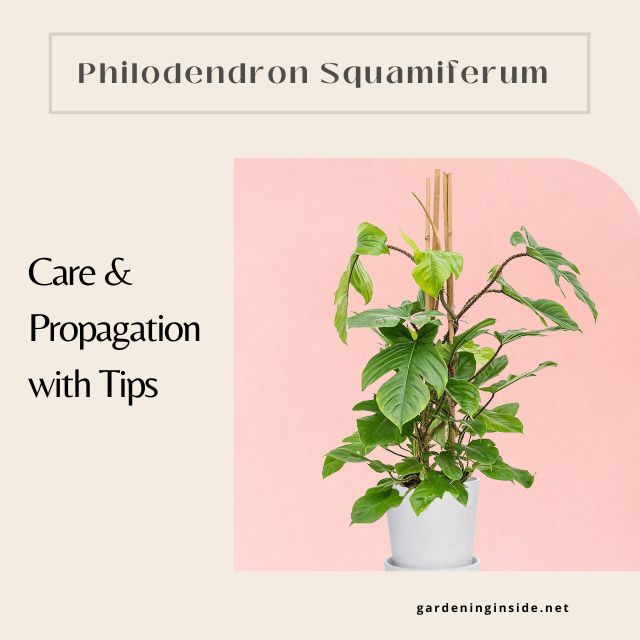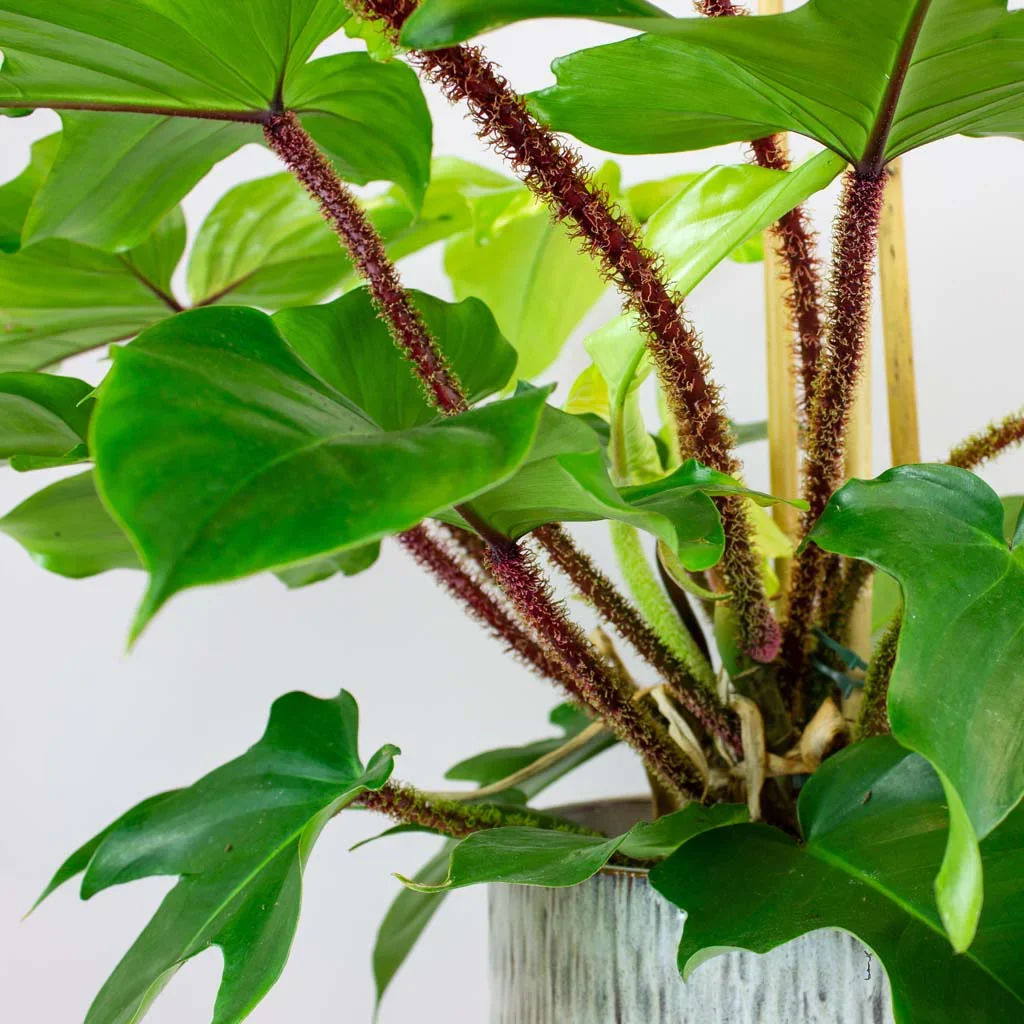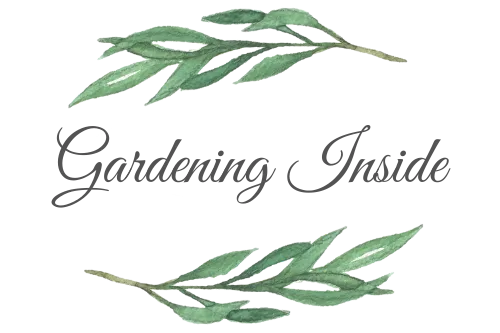The Squamiferum, also called Hairy Philodendron, is a tropical enduring known for thick and rough foliage. It develops well with legitimate lighting, well-depleting soil, and high humidity.
The exceptional feature of this plant is that its stems are covered with fluffy red hair, referred to as pubescence. Subsequently, the usual name is “Hairy Philodendron.”
The Philodendron Squamiferum is something other than a houseplant, and it tends to grow outside in specific environments. Hardness zones 9-11 are the best areas for this plant.

Characteristics of Philodendron Sqaumiferum
In its native environment, there is no restriction to how tall a Philodendron squamiferum can develop. The Philodendron grows upward to extremely high trees.
Leaves are petiole terete, ruddy, 10-15 cm long, 3-4 mm thick, dressed in wide little, spreading, whole or palmatifid, 4-5 mm long scales.
Indeed, even a solitary leaf on a full-grown plant can grow 18″ long. Berries are pale pink, scarcely 2 mm long, 6-9-locular, locules 2-3-cultivated. Seeds are pink-purplish, elliptical ellipsoid, and sulcate-striate.
The scientific characteristics of the philodendron squamiferum are as follows.
| Scientific Name | Philodendron Squamiferum |
| Genus | Philodendron |
| Family | Araceae |
| Habitat | French Guyana, Suriname and Brazil |
| Common Names | Red Bristle Philodendron, Hairy Philodendron |
Other famous varieties of this genus to consider include:
- Philodendron Mamei
- Philodendron Goeldii
- Philodendron Florida Ghost
- Philodendron bipinnatifidum
Philodendron Squamiferum Care Guide
Watering Requirements
Philodendron Squamiferum is one of the most water-sensitive Philodendrons. The pot should have proper draining, and potting medium should not be prone to waterlog.
Temperature Requirements
The ideal temperature for the growth of Philodendron Squamiferum is between 70oF-80oF (21oC-26oC).
Avoid temperature droughts and keep your plant away from heat vents.
Humidity Requirements
Philodendron Squamiferum loves moderate to high humidity for good growth. Maintain humidity level between 40%-90%.
Light Requirements
Place your Philodendron Squamiferum where it gets plenty of indirect sunlight.
Do not place your Philodendron in a dark room, as it may slow down your plant growth.
Soil and Fertilizer Requirements
For the development of Hairy Philodendron, the soil must have a neutral to acidic pH, approximately 5.1-6.0. A well-draining soil should be used so you won’t need to be overly worried.
A slow-releasing organic fertilizer is best for Philodendron Sqaumiferum. Fertilize your plant every three months in spring and summer.
In winters, the plant growth is slower than usual, and do not fertilize your plant this season.
Pruning Philodendron Squamiferum
Philodendron Squamiferum may need pruning to get rid of dead and wilted leaves. The plant may be pruned to control its shape and size.
Use sterilized scissors or a knife to prune your plant. The cuttings from the plant can also be propagated.
When should Philodendron Squamiferum be Repotted?
Since the plant won’t go through unexpected development prods, you don’t need to stress a lot over repotting. If roots are noticeably jabbing out of the pot, now is the right time to change to a larger pot.
Sometimes, you might have to do a repotting if there’s a chance of fertilizer developing in the soil or just spruce up the soil, assuming a lot of time has elapsed since the last treating.
Also Check: Philodendron Burle Marx Care & Growth (All you need to know)

Propagation of Philodendron Squamiferum
Stem cutting is the best method to propagate the Philodendron Squamiferum. Stem cuttings can be propagated in the soil as well as in water. Another technique to propagate Philodendron is by air layering.
Propagation by Stem Cuttings (In Soil)
Stem cuttings straightforwardly established in the soil are a problem-free method for proliferating your Hairy Philodendron. It is prudent to proliferate this plant when it’s effectively developing right on time to pre-summer.
- Select a healthy part of your plant with new development. Cut at least 3 inches long stem with few noticeable hubs. Use disinfected scissors to keep your plant away from bacterial contamination.
- Place the cutting in moist soil with the hubs covered. Then pack the soil around the stem to hold up the cutting.
- Habitually soak the soil to empower quicker growth. Keep the plant close to a window in splendid, circuitous daylight.
- In 2-3 weeks, new buds will develop on the top leaves. This implies that your cutting is presently established!
Propagation by Stem Cuttings (In Water)
To propagate Hairy Philodendron cuttings in water, follow this step-by-step guide.
- Cut the stem just under a hub utilizing a sharp sterilized blade. Eliminate blossom stalks and lower leaves so your cutting can develop roots.
- Put the cutting in an old glass container and fill it with water. The stem underneath the water should not have any leaves.
- A sufficiently bright window with a great wind stream is the best area for your new plant. Keep a humidifier close by to keep the leaves lively.
- Check every 3-5 days to check whether the water should be renewed with a fresh bunch.
- When the roots are about an inch or longer, your slicing is fit to be pruned in soil.
Toxicity
Philodendrons contain insoluble calcium oxalate crystals. Ingestion can cause severe irritation.
Also Read: Cracking Philodendron Verrucosum Care & Propagation Secret
Common Problems and Solutions
Generally, the Hairy Philodendron is an infection-safe and pests-safe plant. There are, notwithstanding, a few usual issues that can influence it.
Few problems associated with Philodendron Squamiferum, along with the solutions, are discussed below.
Pests
Philodendron Squamiferum is prone to spider mites, fungus gnats, and scale insects.
Spider mites damage the plant by causing tiny yellow or brown patches.
Scale insects cause wilted plant leaves.
Fungus gnats feed on the organic matter in the soil and deplete the soil of nutrients.
In case of any of these infestations, use neem oil or insecticides.
Brown Leaf Tips
Low humidity or too much sunlight can cause the leaf edges of Philodendron Squamiferum to turn brown.
Maintain proper growth conditions to avoid brown leaf edges.
Root Rot
Root rot may be caused due to multiple reasons. Carefully examine your plant for overwatering, soil fungi, or improper drainage, if the roots of the plant are rotting.
Root rot can not be cured, so prevention is better in this case. Too much water is the main reason for root rot.
Conclusion
The philodendron squamiferum is easy to please, yet you indeed do have to give close consideration to its watering needs, so you don’t overwater this plant.
Place the plant in a spot where it gets ample indirect sunlight, yet do not expose your plant to direct light.
Because Philodendron Squamiferum is a climbing plant, it’s ideal to offer the plant a help construction or lattice that it can get on and fill in a vertical pattern.
Similarly, you might have to prune the plant due to its capacity to develop to a significant size. Happy Gardening!!!
Frequently Asked Questions about Philodendron Squamiferum
Is philodendron Squamiferum a fast grower?
Philodendron squamiferum is not the quickest grower. As such, it’s not the heaviest feeder either.
What is the rarest Philodendron?
The rarest Philodendron on this list is the Philodendron Spiritus Sancti.
Part of the charm of this Philodendron squamiferum is its unusual-shaped leaves with fuzzy red stems. This plant is a relatively rare species of the Philodendron family and would make a great addition to any plant collection.
What is the difference between Squamiferum and Squanicaule?
Squamicaule has oval-triangular leaves with sagittate to heart-shaped base, while Philodendron squamiferum has five-lobed leaves, i.e., two base lobes, two middle, and one anterior lobe.
